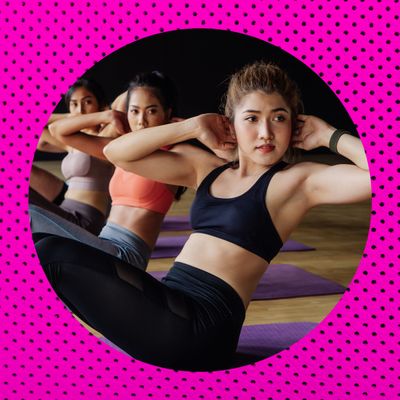
“Hot Bod” is a weekly exploration of fitness culture and its adjacent oddities.
When I was a little kid, my mom had a particular exercise VHS she’d put on when she got home from work. It featured people in aerobic bodysuits with the highest bikini cut possible who were constantly targeting an oblique. I had never heard such a sophisticated concept. While my mom did her videos, I’d bounce around on the bed and chat at her and do impressions of the self-serious instruction. Obliques! Obliques! This wasn’t an arm or a leg: Obliques sounded like an absolutely imagined body part. They sounded like a worldly secret. I loved them instantly.
And I love them still. Obliques are basically side/waist muscles; they run diagonally, on a bias, from your lower ribs to your pelvis on each side and connect to your abdominal muscles. They help your torso bend, rotate, and flex. If you stand up, legs together, reach your arms to the ceiling, and then lean your torso right and then left, the pulling feeling heat down your side is your oblique muscles. Whenever they tug, they initiate this amazing under-the-skin satisfaction, like your back cracking, but fluid.
But, despite feeling great to use and to say (obliques!), they’re unfairly overlooked. In my full course load of the internet’s digital streaming fitness classes, I hear obliques mentioned rarely enough that I perk up when an instructor gives them their highly deserved, direct attention. I love to hear them spoken, as much as I love to feel them engaged. Obliques help with balance, posture, stability. They’re to the side, but they’re extremely important and powerful. They’re decorative pillars, they are the best supporting actors. A 2015 study published in the Journal of Physical Therapy Science found that strength training that incorporated obliques exercise helped to lessen chronic back pain. Liz Cuttica, a Barre instructor at Chi-Society and founder of Milly Grey Movement, emphasizes that they might feel so satisfying to focus on exactly because they tend to be overlooked: “The overworked muscle creates compensations and dysfunction. The body can’t fully thrive without all the muscles showing up to the party.”
My love of obliques was recently reinvigorated when I discovered the wood chop with dumbbells, from a trainer who introduced it with an environmentally astute disclaimer: “Of course, we would never actually chop down a tree.” There’s such a substantial, probing twist with this, coiling down the whole side of my body, it’s remained my favorite exercise with weights, even months later. It feels like I’m wringing something out, as if I were a towel. The motions that engage obliques tend to be like this, with names that brag about dynamism and achievement: threading the needle, cross climbers, Russian twists, dumbbell crossover punch, the mermaid. I feel I missed mermaid culture, but I love the mermaid twist oblique exercise: it does feel exactly like sitting on a rock, being superior and limber and super strong.
Like the oblique itself, I know I might be biased. I posed this leading question to some experts: Why do oblique exercises feel so amazing to do? Zach Bergfelt, a Pilates instructor with Onyx, proposes that it’s because as you’re working obliques, you’re also loosening them: “It’s not only stretch, but strength as well.” It’s a feeling of constantly elongating, he says: “Obliques stretches allow my body to reset and find length.” Luis Cervantes, a dancer and co-founder of Fuego Fitness, relies on his obliques to “twist, move, bend, and lean with great speed and agility.” But he says obliques are often overlooked over the muscles around them like abdominals or back: “Our oblique muscles have been working so hard, which is why stretching them out at any time of day tends to feels so great and so needed,” he says, “It really makes me feel like I’m putting the cherry on top of a strong core.” And so, my first instinct about obliques was correct — they are a bit of a secret. You rarely get at a secret directly, you’ve often got to wiggle and finagle a little bit. And then it feels so great to gain access to it.

